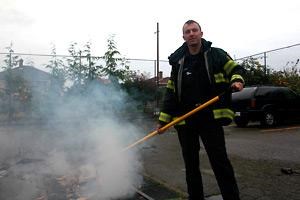With fall’s chill in the air, many residents are lighting up their wood stoves and fireplaces. Officials warn there are health and safety issues to consider, but also ways to minimize risk.
Health Canada advises that exposure to air pollution, which includes wood smoke, appears to play a role in a wide range of adverse health effects like lower respiratory infections, exacerbation of asthma and decreased breathing ability.
“The tendency is to consider wood smoke somehow natural and more innocent than other pollutants,” wrote Dr. Paul Martiquet, medical health officer for rural Vancouver Coastal Health, in a 2011 report on the dangers of wood smoke. “The truth is that the components of wood and cigarette smoke are quite similar and both present health risks.”
Exposure to the pollutants in wood smoke can lead to irritation in the eyes, nose, throat, headaches, nausea and dizziness.
The main pollutants in wood smoke are fine particles called particulate matter, gases which include carbon monoxide and formaldehyde, and volatile organic compounds.
Particulate matter consists of minuscule solid or liquid particles which, because of their size, are able to travel deep into the lungs where they remain for months, irritating bronchial tubes and causing structural damage. Wood smoke’s carcinogenic chemicals adhere to these tiny particles. Particulate matter contributes to smog, especially when it builds up in a low area like a valley or during a thermal inversion.
Carbon monoxide is an odourless, colourless gas that is poisonous at high levels. It affects the ability of blood to deliver oxygen.
“Inhaling wood smoke exacerbates the symptoms of people with lung conditions especially asthma and chronic obstructive lung disease,” said Martiquet.
Despite health risks associated with burning, there are measures that can be taken to minimize exposure to wood smoke.
Powell River’s fire chief Dan Ouellette said that if people pay attention to what they’re doing and burn in an efficient, safe manner using a wood stove or fireplace can work out pretty well.
“A wood-burning unit appliance is like anything we own,” said Ouellette. “It requires maintenance. It’s not one of those things that you can buy, have it installed and never look at it again.”
Ouellette recommends regular annual chimney or wood stove cleaning and inspection and installing smoke and carbon monoxide detectors in the home.
“You need to look at the smoke pipes because they tend to rust out over time because of the heat and the moisture,” he said. “It’s like a muffler on your car.”
Each year Powell River Fire Rescue receives many complaints from concerned neighbours of “nuisance smoke.”
Ouellette said burning garbage is definitely against the City of Powell River’s burning bylaws and that it causes both added risk for house fires and increased poisonous gas release.
Ouellette has some recommendations for reducing the amount of smoke in neighbourhoods and in homes.
“Smaller, hotter fires and not loading the wood burner up and dampering it down goes a long way,” he said.
Ensuring the wood is seasoned reduces the amount of smoke it produces. Seasoned wood usually has been cut and stacked for a year and typically has cracks in the ends.
Storing cut, split and stacked wood outside covered by a tarp or roof with the sides of the wood exposed to air helps dry the wood.
“If you’re burning wood that’s not seasoned and dry you’re going to create moisture which creates steam and smoke,” he added.
In 1995 British Columbia started certifying wood-burning appliances for emissions. Wood stove manufacturers started building more environmentally-sensitive units. These stoves are more efficient and environmentally friendly because they burn off excess gases and reduce the amount of smoke produced as long as users follow the manufacturer’s guidelines. These stoves also release less creosote which, when it builds up inside smoke pipes and chimneys, increases the risk for fires.
“If they’re functioning the way they should,” Ouellette said, “you won’t see much smoke and maybe only the heat wave from it.”
Ouellette recommends stoves and fireplaces that are CSA approved.



